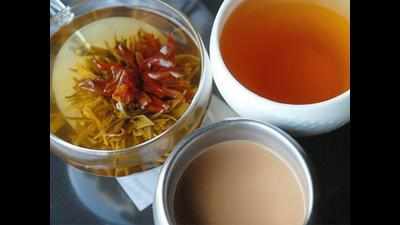- News
- City News
- guwahati News
- Woman entrepreneur from Assam rolls out yellow tea making
Trending
This story is from November 20, 2017
Woman entrepreneur from Assam rolls out yellow tea making
Assam has got green tea, black tea, white tea, oolong tea, orthodox tea and phalap (traditional handmade tea of the Singpho tribe) varieties of tea, besides the largely produced CTC.

Guwahati: Assam has got green tea, black tea, white tea, oolong tea, orthodox tea and phalap (traditional handmade tea of the Singpho tribe) varieties of tea, besides the largely produced CTC. But a woman tea entrepreneur from upper Assam’s Golaghat district has added a new colour to the state’s tea variety--- the yellow tea, perhaps for the first time. Yellow tea, one of the “rarest” brews in China’s list of tea variety and is also known as “royal tea”.The highly-prized yellow tea, which entails meticulous and time-intensive skill for making, is produced in China’s mountainous Hunan, Zhejiang and Sichuan provinces. However, because of the time-consuming process, many have given up yellow tea making in China.
Rakhi Saikia, who owns a 99 hectare organic tea plantation in Golaghat’s Barpathar area, said that she started experimenting with making yellow tea after going through different Chinese literatures on the tea recipe and making some changes in technique to suit the local condition in the state. Pradip Baruah, Senior scientist of Tocklai Tea Research Institute in Jorhat, provided technical guidance to Rakhi for making yellow tea. “On October 23, my experiment yielded success. I have got the light yellow colour, fruity flavor with an aroma of night jasmine and tinge of sweet taste of yellow tea. This is the quintessential characteristic of yellow tea. Initially there was some problem, but later I perfected it through constant monitoring and meticulous handling of the necessary parameters needed to make a yellow tea,” Rakhi said.
Since October 23, Rakhi could make eight kilogram of yellow tea and already a Kolkata-based broker has come forward to procure it.
“I succeeded in making yellow tea with buds, leaves as well as taking bud and leaves together. However, later I opted for buds and leaves together because making yellow tea only with buds makes it very costly and comparatively more time-consuming. As I am completely new in making this new tea variety, I did not want to take risk in increasing the cost in production by using only the buds,” Rakhi explained. Rakhi said that among changes in techniques she made for making yellow tea were in the drying process. “In China, pan drying is done whereas I have gone for drying with a special dryer,” she added. End
Rakhi Saikia, who owns a 99 hectare organic tea plantation in Golaghat’s Barpathar area, said that she started experimenting with making yellow tea after going through different Chinese literatures on the tea recipe and making some changes in technique to suit the local condition in the state. Pradip Baruah, Senior scientist of Tocklai Tea Research Institute in Jorhat, provided technical guidance to Rakhi for making yellow tea. “On October 23, my experiment yielded success. I have got the light yellow colour, fruity flavor with an aroma of night jasmine and tinge of sweet taste of yellow tea. This is the quintessential characteristic of yellow tea. Initially there was some problem, but later I perfected it through constant monitoring and meticulous handling of the necessary parameters needed to make a yellow tea,” Rakhi said.
Since October 23, Rakhi could make eight kilogram of yellow tea and already a Kolkata-based broker has come forward to procure it.
“I succeeded in making yellow tea with buds, leaves as well as taking bud and leaves together. However, later I opted for buds and leaves together because making yellow tea only with buds makes it very costly and comparatively more time-consuming. As I am completely new in making this new tea variety, I did not want to take risk in increasing the cost in production by using only the buds,” Rakhi explained. Rakhi said that among changes in techniques she made for making yellow tea were in the drying process. “In China, pan drying is done whereas I have gone for drying with a special dryer,” she added. End
End of Article
FOLLOW US ON SOCIAL MEDIA










